Adeniums, which require some patience at home, are succulent plants native to Africa. A flower from the Kutrovy family, because of its resemblance to rose flowers, is popularly known as the “desert rose”.
Material Content:
Varieties and types
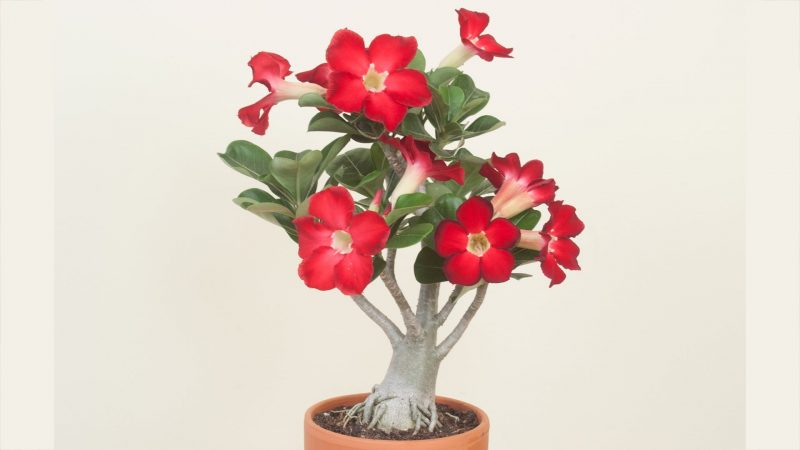
In nature, the genus includes about 5 species, on the basis of which quite a few interesting varieties are derived:
- Adenium arabicum is a plant from Arabia with wide leathery leafy plates, in which there are practically no differences in thickness between the branches and the trunk.
- Adenium boehmianum - a species distinguished by the color of flowers. The purple pharynx contrasts on a white-blue or lilac-pink background of the petals.
- Fat Adenium (obsessum) - a tree-shaped species whose trunk lignifies over time. The maximum height of the succulent, painted in brown-gray, is 1.5 m. When flowering, which is observed in the summer, white, red or pink flowers bloomed in corymbose inflorescences bloom.
- Adenium multiflorum - a representative of exotic flora with flowers as in the previous species, but in larger numbers. The height of the plant in the natural environment can reach 2.5 m.
Adenium - growing characteristics

Succulent, not exceeding 60 cm in the apartment environment, can please the grower with its large tubular flowers throughout the summer, if the following features are taken into account when growing:
- unhindered direct sunlight for 4 hours;
- regular watering;
- providing a phase of rest;
- organization of competent trimming.
Home Care
In order for the succulent to grow healthy and delight the eyes of others, it is necessary to adhere to a number of agrotechnical requirements.
Lighting and location
A native of Africa is very photophilous and does not need shadingif direct sunlight falls on it for no more than 5 hours in a row. Therefore, the window sill of the southern window is suitable for placing the flower.
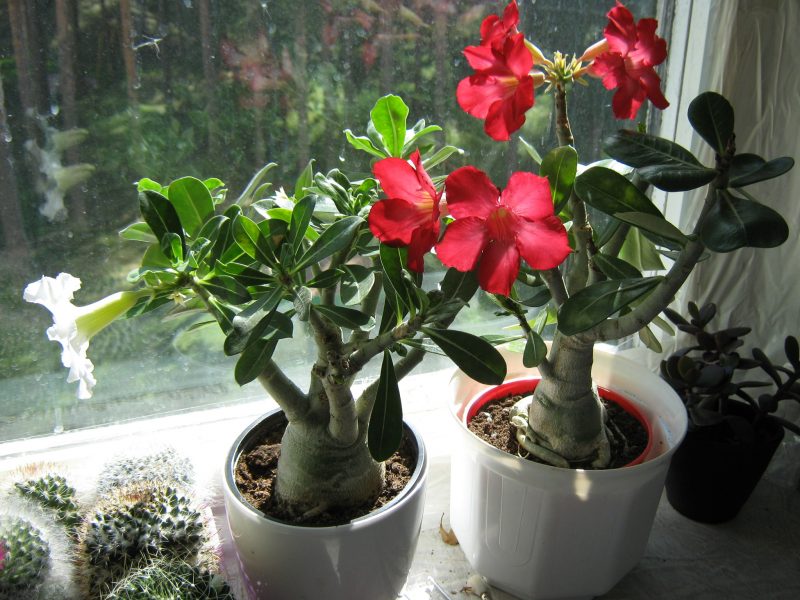
Advice! To prevent burns after a cloudy winter period, you should gradually accustom the succulent to being under the rays of the active sun.
Temperature
When cultivating the plant at home, a certain temperature regime should be provided depending on the phase of development:
- In the phase of active vegetation, the optimal temperature value ranges from 25-30 ° C.
- During the rest period, the temperature regime drops to 12-15 ° C.
Caution! Do not allow the temperature to drop below 10 ° C - this can lead to hypothermia of the roots of the succulents and death of the plant.
Watering
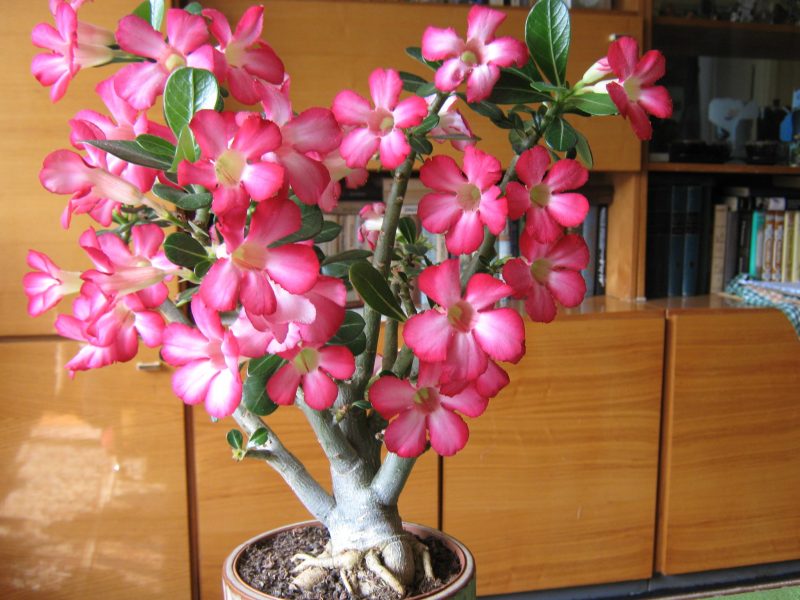
- In the spring-summer season, the adenium is provided with regular hydration, in which each new portion of the water is poured under the flower after the substrate has completely dried.
- With decreasing temperature and the suspension of vegetation, watering is reduced.
- In early spring, when the flower leaves its dormant state, the first watering is carried out after the start of active growth.
Air humidity
During the growing season, the plant is sprayed from a finely divided spray. However, during flowering during the procedure, care must be taken so that water does not fall on the flowers
Top dressing
Adenium is recommended to be fed monthly during the period of active growth with the help of liquid fertilizers for succulents.
Adenium trimming and shaping
To form a dense crown, flower growers resort to crop pruning: pruning of the apex leads to awakening of the lateral buds and stimulates branching.

If desired, based on succulents, you can form a bonsai in the form of a mangrove:
- A seedling with a thick base of the central shoot is selected.
- The root is cut at the site of narrowing of the caudex (thickened trunk).
- The stem rooted in perlite.
- After root formation, the plant is transferred to a wide tank, where a plastic plate is placed under the straightened roots, depending on the desired shape.
- The roots are sprinkled with a layer of substrate 2 cm thick.
Flower Transplant Rules
Young plants are transplanted annually in spring. As the plants grow older, the interval between procedures increases.
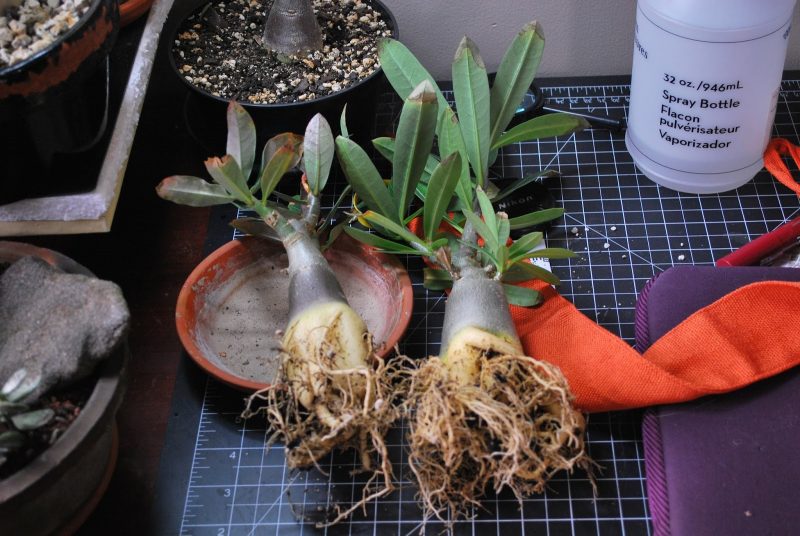
The plant is transplanted according to the following scheme:
- A low but wide pot of light tones is prepared, which protects the plant from overheating.
- A drainage is placed at the bottom of the tank, which is covered from above with a substrate of loose structure from sheet, sod soils and sand in equal shares.
- A flower is planted, which is sprinkled with prepared soil mixture.
Care after flowering
After flowering is complete, the succulent begins to prepare for winter stagnation - all processes slow down. At this time, watering is gradually reduced, and feeding is stopped completely
Pest and Disease Control
Succulents are not prone to disease and pest damage. However, sometimes the adenium can still be attacked by such harmful insects as the spider mite, scutellum and mealybug.
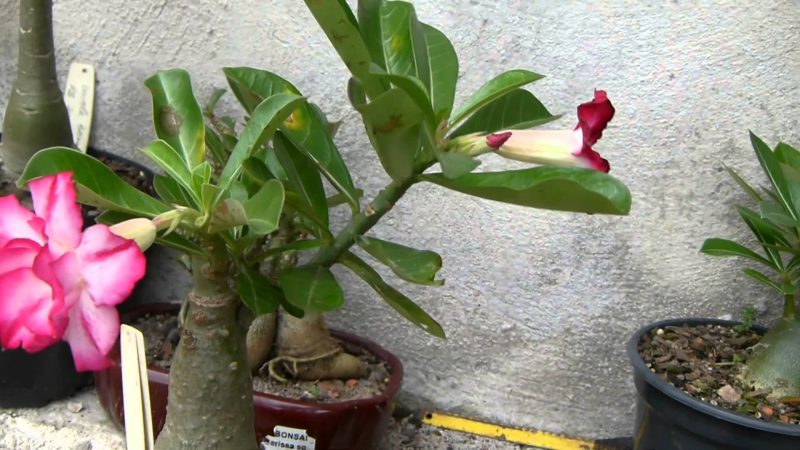
When pests are detected, the flower is treated with an insecticide solution.
Reproduction of adenium
Adenium propagates by both seed and vegetative methods.
Growing adeniums from seeds
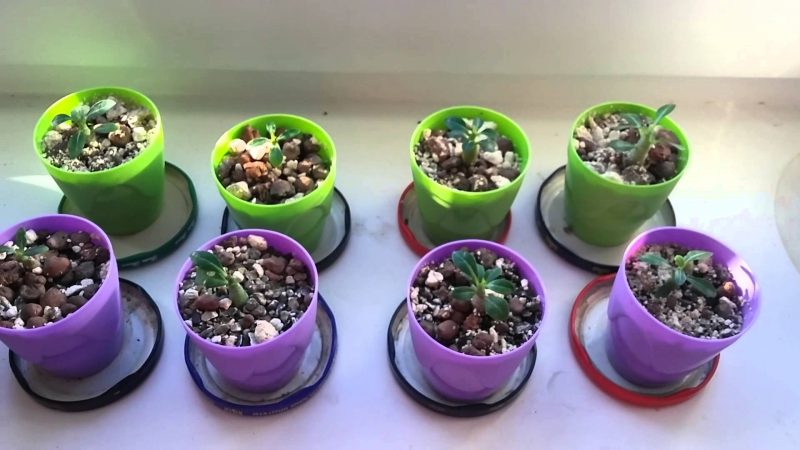
To grow a desert rose from seeds:
- The seedling box is filled with a mixture of perlite and sand in a ratio of 2: 1 with the addition of charcoal.
- Seed material is disinfected for half an hour in a potassium permanganate solution, after which it is distributed over moistened soil and slightly crushed by it.
- The container moves to a warm, bright place with a temperature of 33–35 ° C.
- After the appearance of two pairs of true leaves in the Senti, new plants dive into separate containers.
Important! Pre-germination of adenium seeds, in which they are placed after disinfection in a damp cloth, will allow seedlings to be obtained a little earlier.
Cuttings

A rather complicated procedure due to the rapid decay of cuttings, in which:
- In spring or summer, apical cuttings 15 cm long are cut.
- Places of cuts are processed with charcoal, after which the cuttings are dried in air.
- Rooting is carried out at a temperature of 25 ° C in a special substrate of sand and perlite.
Propagation by layering
The procedure is carried out in late spring – early summer, when:
- Shoots with a diameter of 2 cm are selected, on which cuts are made with a sharp tool.
- Damaged places are treated with a growth stimulator and turn into sphagnum, which is fixed with a film and tape.
- After root formation, layering is separated and planted in individual pots filled with the appropriate substrate.
Problems that flower growers may encounter
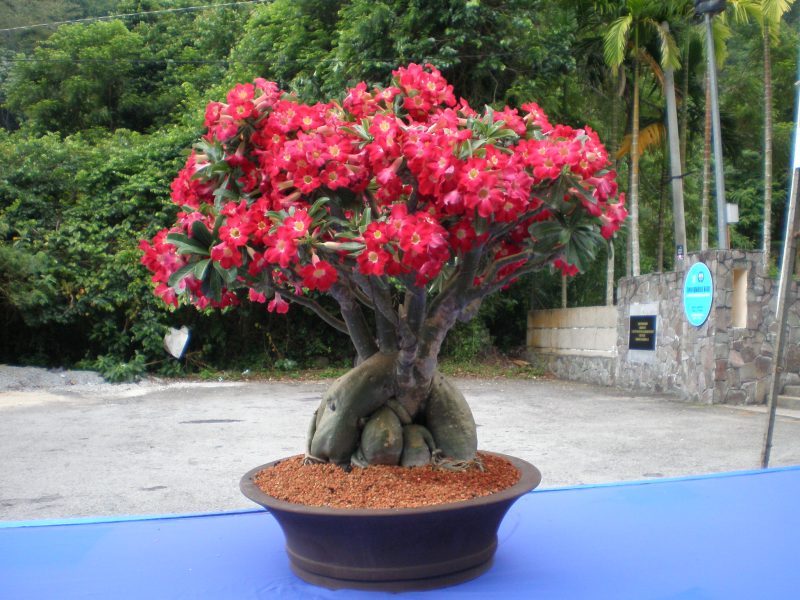
Among the most common problems that arise when growing adenium, the following stand out:
- Yellowing and falling of leaves - the cause of the problem lies in drafts, hypothermia or a sharp change in the usual conditions of detention.
- Fall foliage in the fall is a natural process that precedes the onset of the resting phase.
So, the adenium flower, due to its lush and long flowering, is a spectacular plant, which is often used to decorate window sills.












